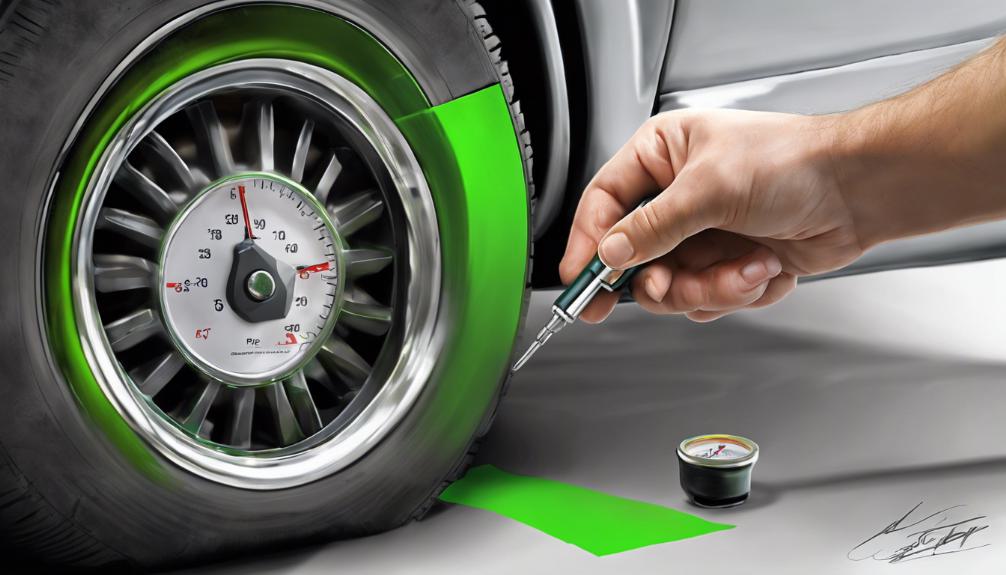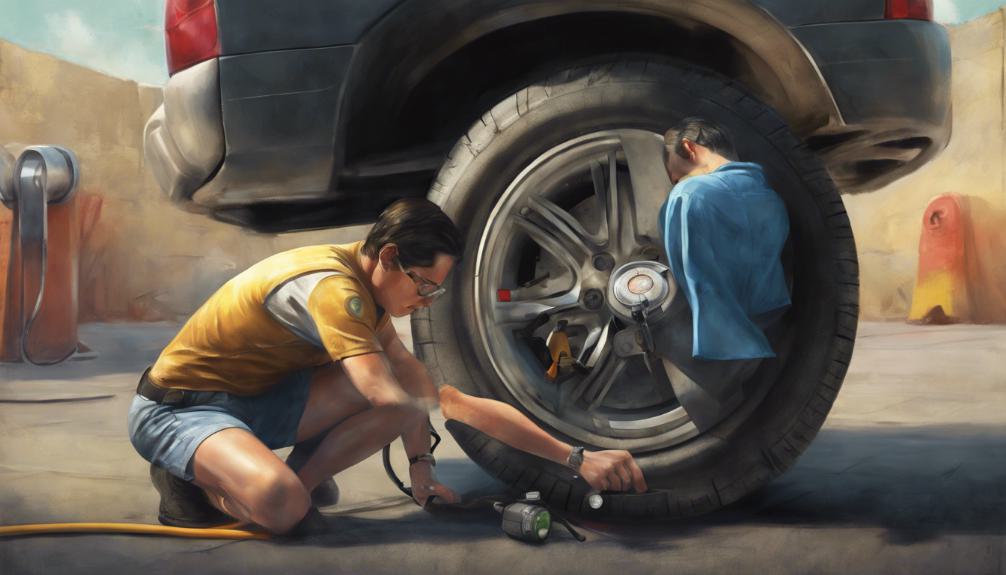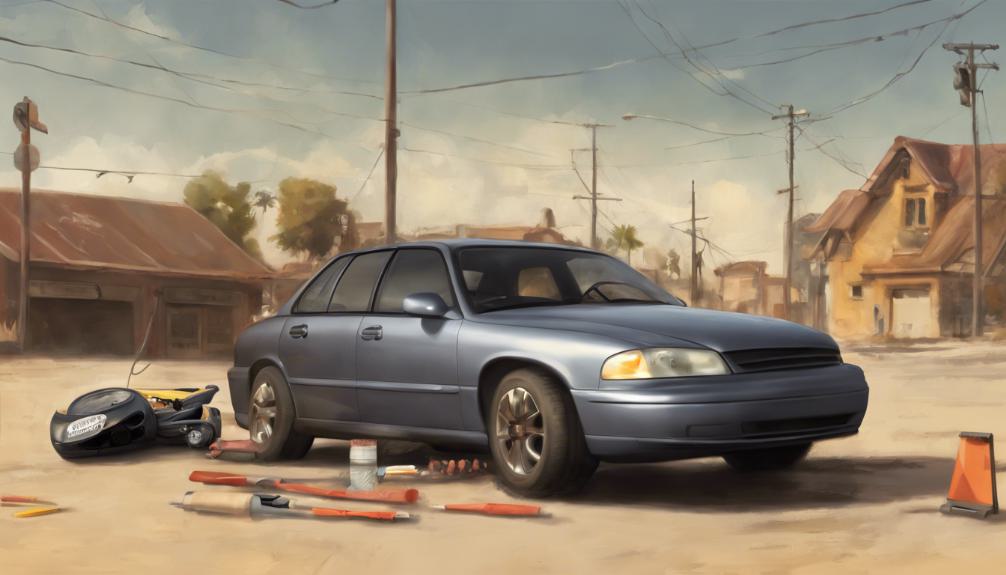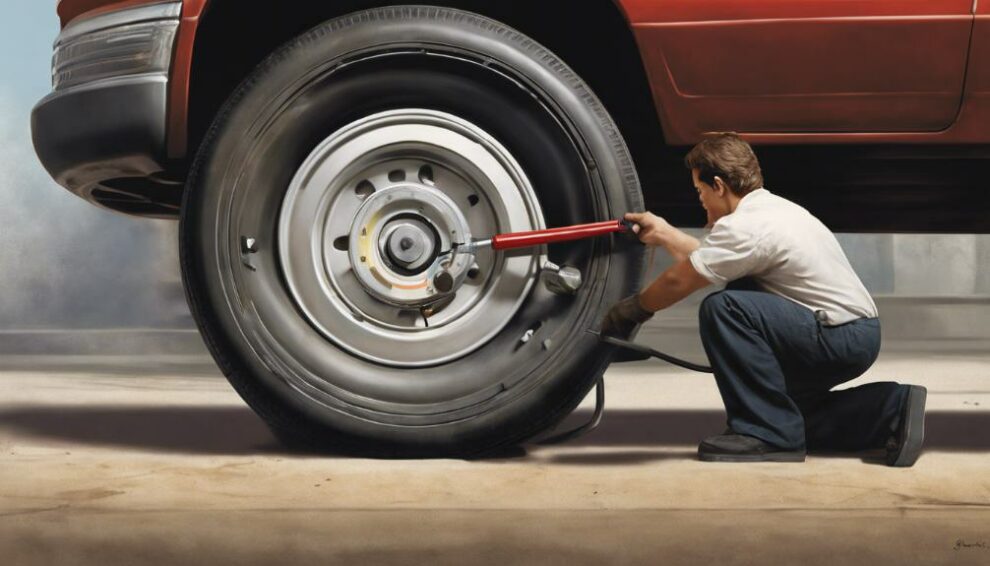To guarantee proper spare tire performance and safety, maintain the correct PSI. Benefits include improved handling and minimized damage risks. Follow recommended levels to avoid safety hazards from under or overinflation.
Check the driver’s door placard or manual for PSI info. Use a pressure gauge for accurate readings. Inflate to the manufacturer’s specified maximum pressure for emergencies.
Regular checks prevent handling issues and damage. Maintain correct pressure for top performance during crises and longer lifespan. For more tips on spare tire maintenance and safe driving, explore further guidance.
What You Need to Know
- Check driver door placard or manual for recommended PSI.
- Utilize a pressure gauge for accurate spare tire pressure readings.
- Inflate spare tire to maximum pressure specified on tire.
- Regularly inspect spare tire for damage and signs of wear.
- Store spare tire in a cool, dry place to prevent deterioration.
Importance of Correct Spare Tire PSI

Maintaining the proper spare tire PSI is vital for ensuring top performance and safety in emergency situations.
The benefits of having the correct spare tire pressure include improved handling, reduced risk of tire damage, and enhanced overall safety on the road.
By following the recommended PSI levels, you can prevent potential safety hazards that may arise from driving with underinflated or overinflated spare tires.
Safety precautions should always be taken when checking and adjusting your spare tire PSI to avoid any mishaps.
Ensuring that your spare tire is inflated to the appropriate pressure, typically around 60 PSI for compact spares, won’t only maximize its effectiveness during emergencies but also extend its lifespan.
Following the manufacturer’s guidelines for spare tire PSI is essential in maintaining readiness for unexpected situations on the road.
Checking Spare Tire Pressure Regularly
Regularly checking your spare tire pressure is crucial for guaranteeing it’s prepared for emergency situations and maintaining overall tire health.
To enhance emergency preparedness, make it a habit to inspect the spare tire pressure monthly or before long trips.
The recommended PSI for your spare tire can typically be found on the driver door placard or in the owner’s manual. Utilize a pressure gauge to obtain accurate readings of the spare tire PSI.
Inflation techniques may vary based on whether your spare tire is a full-size spare or a compact temporary one.
Insufficient pressure in the spare tire can lead to handling issues and potential tire damage, compromising your safety on the road.
By regularly inspecting and maintaining the spare tire pressure, you can prevent potential roadside emergencies and ensure that your spare tire is always ready for use when needed.
Adjusting Spare Tire PSI Safely

To guarantee safe operation, adjust the spare tire PSI to match the recommended air pressure indicated on the driver door placard. Inflating the spare tire to the maximum pressure specified on the tire’s side is advisable for emergency readiness.
Proper inflation ensures your spare tire is in top condition when needed.
- Follow Manufacturer’s Recommendations: Always adhere to the manufacturer’s recommended air pressure for your spare tire as indicated on the driver door placard.
- Emergency Readiness: Inflating the spare tire to the maximum pressure specified on the tire’s side ensures it’s prepared for emergencies.
- Regular Checks: Spare tires may not be checked regularly, so ensuring they’ve sufficient air pressure is important for emergency situations.
- Top Performance: Maintaining the correct air pressure in your spare tire is essential for it to perform at its best during emergencies.
Tips for Maintaining Spare Tire
Maintain your spare tire in excellent condition by practicing these practical tips for its upkeep.
Regularly check the tire pressure of your spare to make sure it matches the recommended PSI for your vehicle. Keeping a portable tire inflator or gauge in your car makes this maintenance task convenient.
Then, inspect the spare tire for any signs of damage such as cracks, cuts, or bulges. It’s important to rotate the spare tire during regular tire rotations to prevent uneven wear and extend its lifespan.
Storing the spare tire in a cool, dry place is vital to prevent deterioration and ensure it remains ready for emergency use.
Safe Driving With Proper Spare Tire PSI

Ensuring your spare tire is set to the recommended air pressure for safe driving is essential. Here are some tips for safe driving with proper spare tire PSI:
- Emergency preparedness: Having the correct tire pressure in your spare ensures you’re ready for unexpected situations on the road.
- Tire safety: Properly inflated spare tires contribute to better vehicle handling and stability, enhancing overall safety.
- Roadside assistance: With the right spare tire PSI, you reduce the risk of needing roadside help due to a flat or improperly inflated spare.
- Tire maintenance: Periodically checking and maintaining the spare tire pressure is vital for ensuring it’s reliable when you need it most.
As an Amazon Associate we earn from qualifying purchases.










